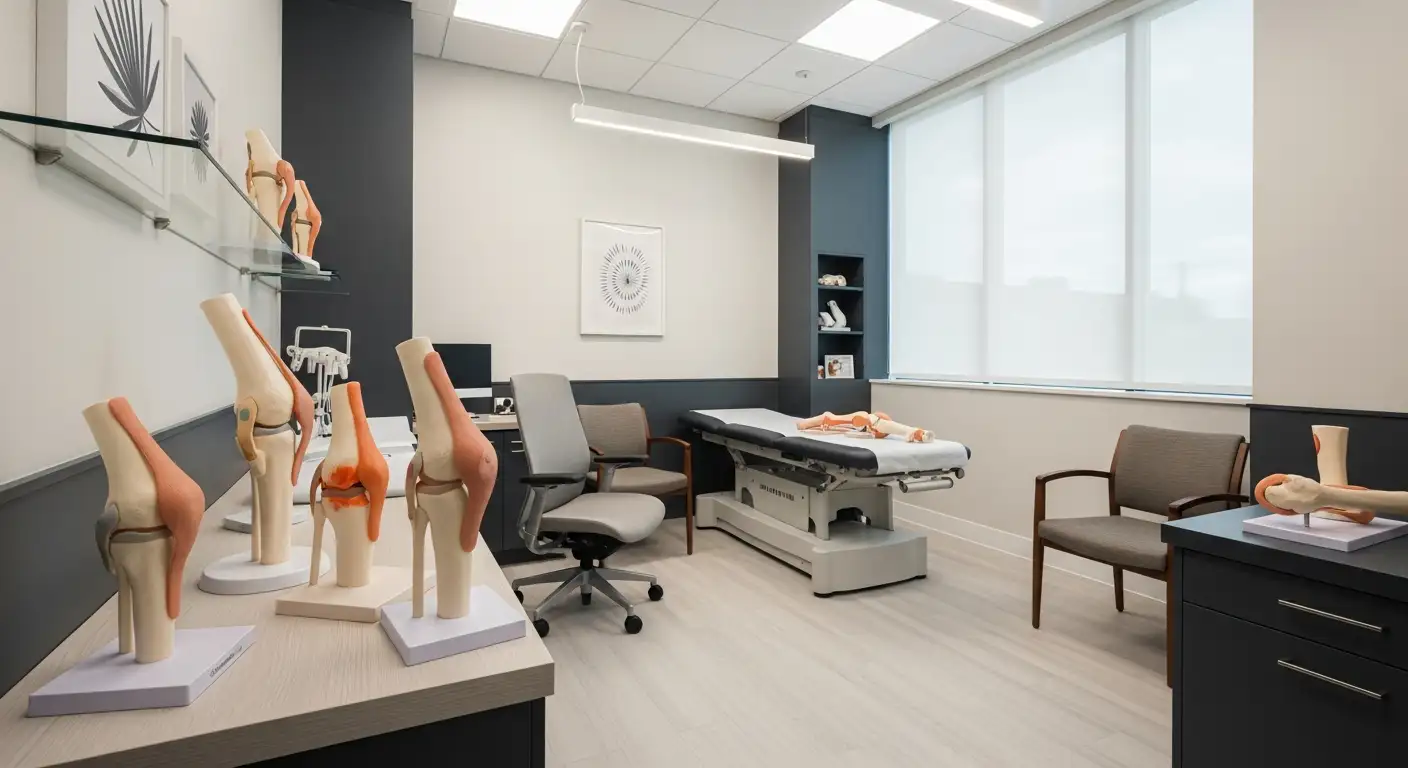Unlocking the Power of Self-Monitoring in Osteoarthritis Care
Osteoarthritis (OA) is a degenerative joint disease characterized by cartilage breakdown and inflammation, posing significant challenges for management. Incorporating journaling into OA care offers a promising approach to track disease progression, optimize treatment strategies, and empower patients through self-management techniques. This article explores how structured journaling can be a vital tool in understanding and managing OA effectively, supported by scientific evidence and practical advice.
Benefits of Journaling in Osteoarthritis Management

How does symptom monitoring through journaling help in managing osteoarthritis?
Journaling allows individuals with osteoarthritis (OA) to track their symptoms consistently, including pain levels, joint stiffness, and functional capacity. Recording daily experiences helps identify patterns, triggers (like specific activities or dietary habits), and moments of relief. This detailed documentation provides valuable insights that can guide personalized treatment adjustments.
Why is emotional wellbeing included in osteoarthritis journaling?
Managing OA isn't just physical; emotional health plays a significant role. By journaling feelings, stress levels, and mental health, patients gain a comprehensive view of how emotional states influence physical symptoms. Regular reflection can ease anxiety, reduce depression, and promote a more positive outlook, contributing to overall health.
How does journaling support adherence to treatment plans?
Documenting medication use, exercise routines, and dietary habits helps reinforce commitment to treatment strategies. Visualizing progress or setbacks motivates patients to stay consistent, which can lead to better pain management and functional improvements. Sharing this information with healthcare providers further enables tailored interventions.
What role does neuroplasticity play in the benefits of journaling?
Journaling encourages neuroplasticity—the brain's ability to rewire itself. For people with chronic pain conditions like OA, this means consciously changing perceptions of pain or discomfort. Regular self-reflection and positive mental focus can help reprogram pain pathways, potentially reducing the severity and emotional impact of pain.
Additional advantages of journaling include:
- Facilitating communication between patients and healthcare professionals through detailed health records.
- Reinforcing healthy behaviors like physical activity and weight management.
- Offering a safe space for self-reflection, which can enhance coping skills.
By integrating journaling into the management plan, individuals with osteoarthritis can better understand their condition and take proactive steps towards improving their quality of life.
Methods and Techniques for Tracking Osteoarthritis Symptoms
What symptom categories should I record?
Tracking osteoarthritis (OA) symptoms involves documenting various aspects of the condition to gain a comprehensive understanding of its impact. Key categories include pain levels, joint stiffness, swelling, fatigue, emotional well-being, sleep quality, medication intake, daily activities, and physical improvements such as increased mobility or strength. Recording these details over time helps identify patterns, triggers, and the effectiveness of treatments.
What digital tools and apps are available?
Using technology makes symptom tracking more accessible and efficient. Mobile apps designed for health monitoring enable users to log symptoms daily with ease. These apps often come with customizable entries, reminders, and visual progress charts, helping patients stay consistent in their reporting.
Which adaptive tools can help with joint pain?
For individuals with joint pain, ergonomic and adaptive tools can facilitate journaling without added strain. Voice recognition software allows hands-free recording, reducing the need for typing or writing. Ergonomic accessories like supportive writing aids or styluses can make manual journaling more comfortable, especially during flare-ups or periods of increased pain.
How do structured journaling approaches assist in symptom tracking?
Structured methods like bullet journaling or the use of prompts tailor the process to individual needs. These approaches help break down complex health information into manageable entries, prompt reflection on specific symptoms, and ensure consistency. For example, daily prompts can remind users to record pain intensity, emotional states, or activity levels, making self-monitoring more organized and less overwhelming.
Regular and detailed recording of OA symptoms not only helps in early detection of disease progression but also fosters better communication with healthcare providers. By maintaining these records, patients can better understand their condition, adhere to treatment plans, and make lifestyle modifications that improve their quality of life. Combining traditional journaling with digital tools and adaptive strategies creates a personalized approach to managing osteoarthritis effectively.
Monitoring Disease Progression with Journaling
How can journaling help in tracking disease and functional changes?
Journaling offers a practical way for individuals with osteoarthritis (OA) to systematically record their symptoms, pain levels, and daily functional abilities. By noting these aspects regularly—such as pain intensity on a visual analog scale (VAS) or specific activities that trigger discomfort—patients create a detailed personal record. This ongoing documentation allows both patients and healthcare providers to identify patterns over time, such as increases or decreases in pain, stiffness, or mobility issues.
Specific entries might include activity logs, medication use, and responses to therapies. When this information is paired with physical assessments, it paints a full picture of the disease’s trajectory, helping to evaluate whether particular interventions are effective or if adjustments are needed.
What is the relationship between journaling, biomarkers, and imaging?
While subjective journaling provides valuable insights, correlating these personal records with objective measurements enriches understanding. Biomarkers like IL-6, NFκB, and MMP-13 can indicate levels of inflammation associated with OA progression. Imaging techniques—for example, radiography or MRI—measure structural changes like joint space narrowing or cartilage loss.
Researchers and clinicians compare self-reported symptom fluctuations with these biomarkers and imaging results to monitor disease evolution. For example, a patient’s report of worsening pain might coincide with increased biomarker levels and detectable joint deterioration on imaging, confirming disease progression.
Why is long-term documentation beneficial?
Maintaining a detailed journal over months or years helps track subtle shifts in the disease course. Recognizing early signs of progression enables timely intervention, potentially slowing further joint damage.
Additionally, longitudinal records support personalized treatment plans, motivate adherence to preferred therapies, and serve as communication tools during medical consultations.
Recent studies highlight the importance of outcome measures like joint space width changes of ≥0.4 mm, assessed through imaging, alongside patient-reported data, to define meaningful clinical changes.
By combining subjective experiences with clinical and molecular data, journaling enhances comprehensive disease management, helping patients and providers make informed decisions about ongoing care.
| Aspect | Monitoring Benefits | How It’s Achieved | Additional Notes |
|---|---|---|---|
| Symptom and functional change tracking | Detects patterns over time | Patient diaries, apps, self-assessment | Supports lifestyle and treatment adjustments |
| Correlation with biomarkers and imaging | Validates symptom reports | Blood tests, MRI, X-ray | Confirms biological and structural changes |
| Long-term documentation benefits | Early detection of progression | Continuous recording over years | Enhances personalized care and research |
By utilizing journaling alongside biomarker and imaging assessments, patients and clinicians can achieve a well-rounded understanding of osteoarthritis progression, ultimately leading to better management strategies.
Assessing and Improving Treatment Strategies through Journaling

How can journaling be used to evaluate and improve osteoarthritis treatment strategies?
Journaling offers a practical way for individuals with osteoarthritis (OA) to systematically track their symptoms, pain levels, activities, and responses to various treatments. By documenting daily experiences, patients can identify patterns such as specific movements, foods, medications, or activities that either worsen or alleviate their symptoms. This detailed record helps both patients and healthcare providers understand what interventions are most effective.
Consistent use of a pain journal or mobile app enables patients to monitor changes over time, making it easier to see whether symptoms improve with new therapies or lifestyle adjustments. For example, recording variations in pain after starting an exercise program or changing dietary habits can provide valuable insights.
Tracking emotional wellbeing alongside physical symptoms creates a comprehensive picture of how arthritis impacts overall quality of life. This holistic approach supports tailored treatment strategies that address both physical and emotional health.
Ongoing documentation also helps in evaluating the efficacy of medications or physical therapies like resistance training, aquatic exercises, and weight management efforts. By noting improvements or setbacks, patients can work with their healthcare team to fine-tune treatment plans.
Additionally, visual records of progress—such as reduced pain scores or increased range of motion—can motivate patients and reinforce adherence to prescribed routines. If a treatment is not yielding expected results, the collected data serves as evidence to discuss alternative options.
Communication with healthcare providers is streamlined when patients bring detailed symptom records to appointments. This real-time data allows clinicians to make informed decisions about adjusting medications, recommending additional therapies, or scheduling further diagnostic testing.
Outcome measures from recorded data, such as changes in joint space width or functional scores, help assess disease progression and treatment impact objectively. Converting continuous data into categorical responses (e.g., responder vs. non-responder) further clarifies treatment effectiveness.
Overall, journaling acts as an empowering tool, enabling patients to take an active role in managing osteoarthritis. By fostering self-awareness and providing tangible evidence of progress or challenges, it lays the foundation for more personalized and adaptive treatment strategies, ultimately improving quality of life.
Scientific Evidence Supporting Journaling in OA Management

Is there scientific evidence supporting journaling as a tool for osteoarthritis management?
Current scientific research on the use of journaling specifically for osteoarthritis (OA) management is relatively limited. However, emerging evidence supports the role of self-management strategies that can include structured activities such as journaling or symptom tracking.
Digital health programs and apps that encourage patients to record their symptoms, medication use, and physical activities have demonstrated moderate benefits in reducing pain and improving physical function. These benefits often persist for up to a year, indicating that consistent self-monitoring can influence disease outcomes.
In addition, general self-monitoring approaches like journaling, combined with patient education, have been shown to enhance pain management and psychological well-being. Patients who actively track their symptoms and responses to various treatments tend to better recognize triggers and adapt their management behaviors.
While direct evidence linking journaling alone to specific improvements in OA remains sparse, related interventions support its potential. By fostering greater symptom awareness and encouraging active participation, journaling can serve as an effective complement to conventional treatments such as medication and exercise.
In conclusion, although more targeted research is necessary, current insights suggest that journaling, embedded within comprehensive self-care strategies, may be a valuable tool in osteoarthritis management. Its role in promoting patient engagement and personalized care underscores its emerging importance.
| Evidence Source | Impact on OA Management | Additional Notes |
|---|---|---|
| Digital self-management programs | Moderate pain relief; improved function | Benefits sustained 12 months; supports structured tracking |
| Self-monitoring and education | Enhanced pain control; better psychological outcomes | Promotes symptom awareness and active engagement |
| General health studies | Increased adherence to treatment; improved well-being | Journaling encourages neuroplasticity and self-reflection |
Though more high-quality research is needed, current data indicate that incorporating journaling into OA self-management routines can promote better health outcomes.
Practical Tips for Effective Journaling

How can osteoarthritis patients implement effective journaling practices?
Maintaining a regular journaling routine is essential for managing osteoarthritis symptoms effectively. Patients are encouraged to organize their entries consistently, focusing on key aspects such as pain levels, activity routines, medication schedules, and physical improvements. Creating clear categories or sections within the journal helps in systematically tracking physical symptoms alongside emotional wellbeing.
Writing about emotional states and motivational reflections can also play a vital role in disease management. Including notes about mood, stress levels, and positive experiences not only offers emotional support but can also help identify psychological triggers or patterns associated with flare-ups.
To accommodate joint discomfort, patients should consider using adaptive tools. Thick-tipped pens or markers can make writing easier, while voice recognition software enables dictation without physical strain. Typing on ergonomic keyboards or tablets can also reduce joint stress during recording.
Regular breaks during journaling sessions are crucial to avoid fatigue and discomfort. Timing these sessions during high-energy periods can help ensure detailed and more consistent entries.
Sharing journal content with healthcare providers provides a detailed snapshot of daily symptoms, medication effects, and triggers. This information can inform personalized treatment plans and help adjust therapies more effectively.
Multiple journaling approaches can be beneficial. Expressive writing, gratitude journaling, or bullet journaling can be tailored to individual preferences, making self-monitoring more engaging and sustainable.
In summary, effective journaling combines consistency, organization, adaptive tools, emotional reflection, and open communication. These strategies empower osteoarthritis patients to better understand their condition and actively participate in their treatment journey, ultimately improving quality of life.
Educating Patients on the Role of Journaling in OA Care
How can healthcare providers educate patients on the role of journaling in osteoarthritis care?
Healthcare providers play a vital role in encouraging patients to utilize journaling as a tool for managing osteoarthritis (OA). One effective approach is demonstrating how to accurately record symptoms, including pain levels, activity patterns, medication intake, and physical progress. By showing patients specific techniques for documenting their daily experiences, providers can foster greater self-awareness of triggers and patterns related to their condition.
Explaining the benefits of journaling is equally important. Research indicates that keeping a health journal can help reduce anxiety, as patients gain a clearer understanding of their symptoms and treatment responses. Additionally, consistent journaling supports better adherence to prescribed interventions like exercise routines and medication schedules.
A key scientific insight is that journaling can encourage neuroplasticity—a process where the brain rewires itself, which may positively influence pain perception. This mental shift can help individuals reframe their experience of chronic pain, making it more manageable.
To make journals more accessible, clinicians can recommend ergonomic tools such as pens and notebooks designed for joint comfort, digital options like mobile apps, or voice recognition software. These adaptations make consistent documentation easier for those with joint pain, reducing barrier to regular use.
Incorporating journaling into broader educational programs can amplify its benefits. For example, alignment with patient-centered interventions like PEPOA (Patient Education and Physical Office Approach) reinforces the importance of self-management strategies.
Ultimately, personalized guidance, coupled with evidence-based explanations about how journaling impacts health outcomes, can motivate patients to adopt this routine. Regular documentation not only aids self-management but also provides valuable data during healthcare visits, fostering shared decision-making and tailored treatment adjustments.
By emphasizing these aspects, healthcare providers can empower OA patients to leverage journaling as a simple yet powerful tool in their ongoing journey toward better health and improved quality of life.
The Future of Journaling in Osteoarthritis Care

What are the emerging trends and future prospects for journaling in osteoarthritis management?
Journaling is poised to become an integral part of osteoarthritis (OA) management as new technologies and approaches continue to develop. One of the most promising trends is the integration of wearable devices and mobile health apps that can automatically track physical activity, joint movement, and even inflammatory biomarkers such as IL-6 or MMP-13. These digital tools can sync seamlessly with journaling platforms, providing real-time updates that help both patients and healthcare providers monitor disease progression more accurately.
Advanced biomarker tracking may soon allow for personalized disease management, where fluctuations in inflammation levels inform treatment adjustments. For example, if a patient’s biomarker levels indicate increased inflammation, the corresponding journal entries noting pain and activity levels can help evaluate the impact of medications or lifestyle changes.
Artificial intelligence (AI) and virtual reality (VR) are also emerging as potential supports in OA care. AI-powered prompts could encourage consistent journaling and provide personalized self-management tips based on logged symptoms and emotional states. VR environments may offer relaxation and pain distraction techniques, aiding emotional wellbeing and encouraging ongoing engagement with self-monitoring.
In clinical practice, the incorporation of digital journaling platforms into routine care is gaining ground. Telemedicine consultations can utilize documented symptom diaries to inform virtual assessments, facilitating timely and tailored interventions.
As research continues, there is a strong likelihood that journaling will shift from being a complementary activity to a cornerstone of OA treatment. This evolution aims to foster more proactive and precise care, empowering patients with tools that adapt to their unique disease experiences and promoting better long-term outcomes.
| Future Trends | Technology Involved | Benefits | Challenges |
|---|---|---|---|
| Real-time symptom monitoring | Wearables, mobile apps | Improved accuracy, personalized care | Data privacy concerns |
| Biomarker integration | Blood tests, tracking apps | Tailored treatments | Cost and accessibility |
| AI and virtual support | AI prompts, VR environments | Enhanced engagement, emotional support | Technological literacy |
| Digital health platforms | Telemedicine systems | Remote monitoring, convenience | Integration with existing healthcare systems |
The future of journaling in osteoarthritis care will likely blend everyday self-monitoring with cutting-edge technology, fostering a more holistic, patient-centered approach that adapts to individual needs while supporting clinicians in decision-making.
Conclusion: Enhancing Osteoarthritis Outcomes with Self-Monitoring Tools
What is the overall value of journaling in osteoarthritis management?
Journaling has proven to be an invaluable component in the self-management of osteoarthritis. It allows patients to document their pain levels, physical activity, medication adherence, and emotional wellbeing consistently. By maintaining detailed records, individuals can identify patterns and potential triggers that exacerbate symptoms, which is crucial for effective disease management.
Tracking progress over time helps both patients and healthcare providers make more informed decisions. It enhances communication during consultations by providing real-time insights into the patient’s condition, thereby supporting personalized treatment adjustments such as medication, lifestyle changes, or specific rehabilitation protocols.
Furthermore, journaling encourages self-reflection and improves emotional resilience. Managing a chronic condition like OA can be stressful, and journaling helps patients process their feelings, reduce anxiety, and develop a proactive attitude towards their health.
Role of self-monitoring in personalized care
Self-monitoring tools like pain journals and mobile health apps are increasingly essential in customizing osteoarthritis care. They enable continuous tracking of symptoms alongside lifestyle factors like diet, exercise, and medication intake. This comprehensive approach facilitates the identification of effective interventions tailored to the individual’s unique disease progression and response.
Studies support that regular documentation of symptoms correlates with better adherence to physical activity and weight management plans, which are vital in OA management. For example, visualizing improvements and setbacks through journaling can motivate continued effort and foster accountability.
Imaging assessments, such as measuring joint space width via radiography or MRI, complement patient-reported data and help evaluate structural changes. Combining these objective measures with self-reported outcomes like VAS or WOMAC enhances the overall understanding of disease status, guiding more precise treatment strategies.
Encouragement for adoption of journaling practices
Healthcare professionals should advocate for routine self-monitoring as part of holistic osteoarthritis management. Introducing patients to various journaling formats—ranging from traditional pen-and-paper methods to digital apps—can cater to diverse preferences and capabilities. For those with joint pain or dexterity challenges, alternatives like voice recognition or ergonomic typing can be beneficial.
Integrating journaling into daily routines, especially during times of high energy, and scheduled breaks can minimize fatigue associated with the activity. Education about how to interpret journal entries and when to seek medical advice encourages empowered patient participation.
As technological innovations continue to advance, the integration of digital tools offers exciting potential for real-time data sharing and remote monitoring. This connectivity can further personalize and optimize osteoarthritis care.
Ultimately, promoting journaling and self-monitoring aligns with evidence-based guidelines emphasizing patient engagement and self-management. It supports improved outcomes, enhances quality of life, and fosters a collaborative approach between patients and healthcare providers.
| Aspect | Description | Additional Details |
|---|---|---|
| Benefits | Symptom management, emotional health, communication | Aids in pattern recognition, reduces anxiety, improves adherence to treatment |
| Tools | Journals, mobile apps, voice recognition | Customizable to individual needs, accessible for those with joint issues |
| Clinical Relevance | Tracking disease progression, therapy efficacy | Uses measures like joint space width, VAS, WOMAC, and composite indices to assess condition |
| Supporting Evidence | Enhances patient engagement, supports personalized care | Demonstrated benefit in self-management outcomes, though more direct research on journaling specifically is ongoing |
| Future Outlook | Digital integration, real-time sharing | Increased use of technology, personalized health insights, improved communication |
Overall, encouraging patients with osteoarthritis to incorporate journaling into their routine can significantly contribute to better disease management and improved quality of life. Engaged, informed patients are better equipped to navigate their health journeys, making journaling a powerful, accessible tool for lasting wellbeing.
Harnessing Self-Monitoring for Better OA Outcomes
In incorporating journaling into osteoarthritis management, patients gain a powerful self-awareness and communication tool that fosters better symptom control, treatment adaptation, and overall quality of life. As evidence and technology evolve, structured self-monitoring through journaling will continue to play a pivotal role in personalized, patient-centered care, making it an essential element in managing this chronic condition effectively.
References
- Benefits of Tracking Your Arthritis Pain and Progress
- How to Journal with Hand and Wrist Pain - CreakyJoints
- The Critical Role of Physical Activity and Weight Management in ...
- Osteoarthritis Progression: Mitigation and Rehabilitation Strategies
- Monitoring osteoarthritis progression and therapy - ScienceDirect.com
- How to Journal with Hand and Wrist Pain - CreakyJoints
- The Critical Role of Physical Activity and Weight Management in ...
- What is a pain diary and how do I start one? - Versus Arthritis
- What to know about journaling and arthritis - Haka Life Nutrition
- How to Journal with Hand and Wrist Pain - CreakyJoints





